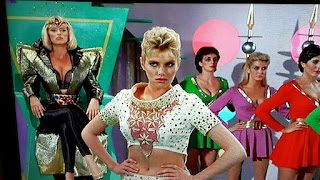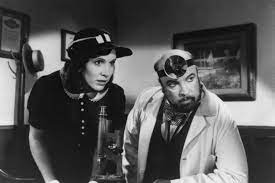(Ti West, USA, rated R, 2022, 105 minutes)
At its most basic level, the slasher film revolves around sex and death. By building his '70s-style horror picture around a pornographic film shoot, Ti West (The House of the Devil, The Innkeepers) makes the connection between the two more explicit--pun intended--than usual. But wait, there's more! Sex isn't subtext in X: it's text.
The action takes place in 1979 as a van full of adult film performers and crew members head towards a rental property somewhere outside of Houston, TX. If that sounds like a twist on the set-up behind Tobe Hooper's immortal Texas Chain Saw Massacre (1974), I can assure you that it is.
There are few, if any, coincidences in Ti West's eight-feature filmography. If you think you've seen something before, you probably have, but the filmmaker has a knack for making his borrowings feel new. Beyond the van full of youngish people and the sun-blasted landscape, the gang passes a dead cow, en route to their destination, in the wake of its evisceration by truck. Not only is it a harbinger of things to come, but the mess of blood and guts evokes the abbatoir milieu of Tobe Hooper's film. Granted, there are no slaughterhouse workers in X, but the film does have a couple of leathery-faces…
Wayne (The Ring's Martin Henderson), the porn film producer, had made arrangements with Howard (Stephen Ure), the property owner, before he'd met the guy or seen the place. It was a different time--no cell phones, computers, or internet searches. Had Wayne taken advantage of any of those tools, it's likely he would've made alternative arrangements, because Howard is one weird and creepy dude. He's also very, very old.
The producer, a relentlessly optimistic type, doesn't let it get him down. He plans to shoot the film in the ranch house attached to the stable, and then split the scene.
His companions include two couples: leggy blonde performer Bobby-Lynne (a very game, very funny Brittany Snow) and the laidback Jackson (actor and musician Kid Cudi) and junior director RJ (The Americans' Owen Campbell) and boom operator Lorraine (You's Jenna Ortega). Wayne's girlfriend, auburn-haired performer Maxine (Nymphomaniac's Mia Goth), rounds out the troupe. He believes the freckled coke fiend has "the X factor" that separates run-of-the-mill adult film performers from superstars.
While the gang shoots a scene with Bobby-Lynne and Jackson, Maxine decides to take a dip in the lake. As she floats on the water, an Ophelia in the sun, a hulking alligator eyes her hungrily. It's another harbinger of things to come, but she has no clue. She slips back into her overall cutoffs, but before returning to the ranch house, she stops by Howard's home, beckoned by the ghostly figure at the door. It's his wife, Pearl, an elderly wraith (played by a certain unbilled actor) who looks at Maxine with a mix of curiosity, jealousy and…something else. She shows her faded photos from when she was young and pretty. Her whole life was ahead of her. Now it's not, and there's a sense that Maxine is a very unwelcome reminder.
The young woman eventually takes her leave. She's rattled, but unharmed. The shoot continues, but it's increasingly clear that the younger people are being watched--and judged--by the older ones. The fire and brimstone televangelist (Simon Prast) constantly ranting from Howard and Pearl's B&W living room TV provides a glimpse into their Old Testament mindset regarding premarital sex (the film's cruel joke is that, though married, they're too decrepit to act on their sexual desires). Once things start to go wrong for Wayne and the gang, they go hilariously, disgustingly wrong.
West, who also wrote the script, co-edited the film with David Kashevaroff, and their cross-cutting creates a destabilizing effect. It's subtle at first before becoming faster and more insidious. The jump scares also prove incredibly effective; some of the best I've witnessed since Jennifer Kent's The Babadook. A haunting, choral-based score from Chelsea Wolfe and The Sacrament's Tyler Bates contributes to the film's dangerously sexy vibe, bolstered by FM staples from Blue Öyster Cult, Robert Palmer, and the like.
By the end, West has put his own "porno chic" spin on the '70s slasher film, with all the requisite toplessness, but he's also made a horror film in which the scariest thing isn't a rusty nail or even a hungry alligator, but an aged human body. He's hardly the first director to do so, since Tony Scott, M. Night Shyamalan, and numerous others got there before him, but the combination of sex and old age--let alone the combination of sex and death--creates a particularly queasy kind of tension. You could call it ageist, and you wouldn't be completely wrong, but it sure got under my skin.















